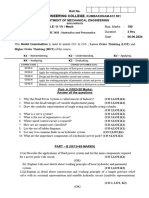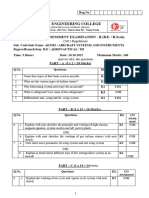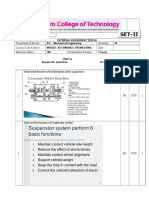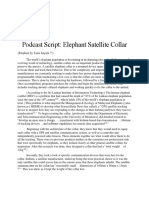0 ratings0% found this document useful (0 votes)
206 viewsAutomobile Question Bank
Automobile Question Bank
Uploaded by
Rajeev RajeevThis document contains a question bank for the course ME6602 - Automobile Engineering at VEL TECH (OWNED BY RS TRUST) Department of Mechanical Engineering. It covers three units: 1) Vehicle Structure and Engines, 2) Engine Auxiliary Systems, and 3) Transmission Systems. For each unit, it lists key terms and concepts and provides short answer and long answer questions to test understanding.
Copyright:
© All Rights Reserved
Available Formats
Download as DOCX, PDF, TXT or read online from Scribd
Automobile Question Bank
Automobile Question Bank
Uploaded by
Rajeev Rajeev0 ratings0% found this document useful (0 votes)
206 views6 pagesThis document contains a question bank for the course ME6602 - Automobile Engineering at VEL TECH (OWNED BY RS TRUST) Department of Mechanical Engineering. It covers three units: 1) Vehicle Structure and Engines, 2) Engine Auxiliary Systems, and 3) Transmission Systems. For each unit, it lists key terms and concepts and provides short answer and long answer questions to test understanding.
Original Description:
automobile question bank
Original Title
automobile question bank
Copyright
© © All Rights Reserved
Available Formats
DOCX, PDF, TXT or read online from Scribd
Share this document
Did you find this document useful?
Is this content inappropriate?
This document contains a question bank for the course ME6602 - Automobile Engineering at VEL TECH (OWNED BY RS TRUST) Department of Mechanical Engineering. It covers three units: 1) Vehicle Structure and Engines, 2) Engine Auxiliary Systems, and 3) Transmission Systems. For each unit, it lists key terms and concepts and provides short answer and long answer questions to test understanding.
Copyright:
© All Rights Reserved
Available Formats
Download as DOCX, PDF, TXT or read online from Scribd
Download as docx, pdf, or txt
0 ratings0% found this document useful (0 votes)
206 views6 pagesAutomobile Question Bank
Automobile Question Bank
Uploaded by
Rajeev RajeevThis document contains a question bank for the course ME6602 - Automobile Engineering at VEL TECH (OWNED BY RS TRUST) Department of Mechanical Engineering. It covers three units: 1) Vehicle Structure and Engines, 2) Engine Auxiliary Systems, and 3) Transmission Systems. For each unit, it lists key terms and concepts and provides short answer and long answer questions to test understanding.
Copyright:
© All Rights Reserved
Available Formats
Download as DOCX, PDF, TXT or read online from Scribd
Download as docx, pdf, or txt
You are on page 1of 6
www.vidhyarthiplus.com www.veltechengg.
com
VEL TECH (OWNED BY RS TRUST)
DEPARTMENT OF MECHANICAL ENGINEERING
ME6602 – AUTOMOBILE ENGINEERING
R 2013
QUESTION BANK
UNIT I VEHICLE STRUCTURE AND ENGINES
Types of automobiles, vehicle construction and different layouts, chassis, frame andbody, Vehicle aerodynamics
(various resistances and moments involved), IC engines –componentsfunctionsandmaterials, variable valve timing
PART A
1 List major types of automobiles according to the fuel used K1
2 List any four components of a chassis K1
3 Express any two requirement of an automobile K2
4 List any four characteristics of a good chassis K1
5 Point out any two requirement of good frame K2
6 Describe about cross windforce K1
7 List few layout of the vehicle K1
8 Describe the purpose of IC engines K2
9 Name any four airpollutants K1
10 Define Electronic Engine Management system? K2
11 Illustrate the functions of a frame? K1
12 Express the type of loads coming to axle? K1
13 Illustrate various loads that are acting on the frame? K1
14 Describe the various components used in IC Engines? K1
15 Describe the various types of frames? K1
16 Point out the stresses to which the frame members are subjected to? K2
17 Point out the materials used in an IC engines? K2
18 Express about Vehicle Aerodynamics? K1
19 What is frameless construction? K1
20 State the functions of push rod and rocker arm. K2
PART B
1 (i)Describe the various components layouts for automobiles
K1
(ii)Discuss the advantages of each.
2 Explain briefly aboutframes K1
3 Describe the followingterms:
a) Load distribution in frames. b) Frame types with neat sketch
c)Framematerials. d) Frametesting.
4 Explain brieflyabout:
Aerodynamic resistance
K2
Gradientresistance
Rollingresistance
5 Explain front and rear wheel drive layout in detail withrelevant sketches K1
6 Explain in detail about Variable Valve Timing. K1
7 Explain in detail about Vehicle Aerodynamics. K2
8 (i) Discuss the frame type construction chassis constructionwithneat sketch
K1
(ii) Discuss briefly about the typical metals used for engineparts
9 Explain briefly the various types of chassis construction with suitable diagram K1
10 Explain the materials used to manufacture the components of engine K2
www.vidhyarthiplus.com www.veltechengg.com
UNIT II ENGINE AUXILIARY SYSTEMS
Electronically controlled gasoline injection system for SI engines, Electronicallycontrolled diesel injection system
(Unit injector system, Rotary distributor type andcommon rail direct injection system), Electronic ignition system
(Transistorized coil ignition system,capacitive discharge ignition system), Turbo chargers (WGT, VGT), Engine
emission control by threeway catalytic converter system, Emission norms (Euro and BS)
PART A
1 Describe the functions of Carburetor? K2
2 List the requirements of a Spark plug? K1
3 List out the main functions of a battery. K2
4 Discuss the functions of Variable Jet Carburetor? K2
5 Discuss the significance of gasoline injectionsystem. K2
6 Illustrate the important units used in electronic fuelinjectionsystem? K1
7 Explain the functions of Unit Injector systems? K2
8 Explain the functions of common rail direct injectionsystem? K2
9 Explain the functions of Electronic ignitionsystem? K2
10 Explain the functions of rotary distributor? K2
11 Explain the function of Transistorized coil ignitionsystem? K2
12 Explain the functions of Turbo chargers? K2
13 Explain the advantages of electronic fuel injection system over conventional injection? K2
14 Discuss the functions of three way catalytic convertersystem? K2
15 Discuss the function of capacitive discharge ignitionsystem? K2
16 Which is the most commonly used supercharger in automobiles? Whypetrol engines are
K2
rarely supercharged?
17 DefineCRDI? K1
PART B
1 Explain the Operational features of electronicsengine management system with neat
K2
sketch
2 Describe the construction and operation of a Simple Carburetor K2
3 Discuss with neat sketch the working of electronicallycontrolledgasoline injection
K2
system for SI engines
4 Illustrate with a sketch the working of a Unit injector system K2
5 Explain the following with suitable sketches: (i)Rotary
K2
distributor(ii)Common Rail Direct Injection System
6 (i) Explain about a Transistorized coil ignition system
K2
(ii) Explain the Capacitive discharge ignition system
7 Explain the multipoint fuel injection system with a neat sketch K2
8 (i) Explain the battery ignition systems with a neatsketch
K2
(ii) Explain briefly the electronic diesel injection system
9 Explain about the Engine emission control by three way catalyticconverter system K2
10 Explain about Emission norms (Euro and BS) K1
11 Explain briefly the electronic diesel injection system withnecessary controls K2
12 Explain the turbo charging system with neat sketch K2
13 What is 3 way catalytic converter? Explain its working principle K2
www.vidhyarthiplus.com www.veltechengg.com
UNIT III TRANSMISSION SYSTEMS
Clutch-types and construction, gear boxes- manual and automatic, gear shift mechanisms, Over drive, transfer box,
fluid flywheel, torque converter, propeller shaft, slip joints, universal joints ,Differentialand rear axle, Hotchkiss
Drive and Torque Tube Drive
PART A
1 List out the functions of clutch and different types of clutches K2
2 What is a freewheel? What is the importance of free wheel in thetransmission of an K1
automobile?
3 Give the function of a differential. K2
4 Discuss the functions of universaljoint? K2
5 List out the various functions of a propellershaft. K1
6 What is known as selectivetransmission? K1
7 Give the types of gear boxes used in an automobile. K1
8 Discuss the double clutchingtechnique? K1
9 Illustrate the difference between torque converter gearbox andfluidflywheel? K2
10 Demonstrate the phenomenon of torque multiplication. K1
11 Discuss the need for a gearbox in an automobile? K2
12 Give the function of a flywheel? K1
13 Define traction effort? K1
14 Give the features of a good qualityclutch? K1
15 Define free wheel and what is its importance in thetransmission of an automobile? K1
16 Compare Hotchkiss drive and Torque Tube drive? K1
17 Explain the functions of a slipjoint. K1
18 What is the use of synchronizer in the automotivetransmissionsystem? K1
19 Explain transfer box and its functions? K1
20 What is a pan hard rod? K1
PART B
1 (i) Explain the working of friction clutches
K2
(ii) What are the assumptions made in pressurecalculation
2 (i) Discuss about working principle of single plateclutch
K2
(ii) Explain about gear shifting mechanism with neat diagram
3 Describe the working principle of fluid fly wheel with the help of a sketch K2
4 Explain the working of a torque converter with suitable diagram Describe in detail
various types of gear selector mechanisms used inautomobiles K2
5 Explain briefly the following (i)Conventional differential (ii)Power lock differential
(iii)Double reduction type differential K2
6 (i)Describe the construction and working of an over drive with a neatsketch and list out
K2
its advantages
7 Illustrate the operation of a
K2
(i)Sliding mesh gearbox, Constant mesh gearbox, Synchromech gearbox
8 Compare hydraulic, mechanical, electrical and vacuum methods of operating clutches K1
9 Explain in detail the automatic transmission system K2
10 Generalize the mechanics of Hotchkiss drive and torquetube drive K1
11 Explain the differential of an automobile with a neat sketch K2
12 (i) Describe a hydraulically operated clutch in detail with the help of simple diagram
(ii) Describe in detail various universal joints used inautomobiles K2
13 Explain fluid coupling and torque convertor K2
14 Explain the working of epicyclic gear box with neat sketch K2
www.vidhyarthiplus.com www.veltechengg.com
UNIT IV STEERING, BRAKES AND SUSPENSION SYSTEMS
Steering geometry and types of steering gear box-Power Steering, Types of Front Axle,Types of Suspension System,
Pneumatic and Hydraulic Braking Systems, Antilock Braking System(ABS), electronic brake force distribution
(EBD) and Traction Control
PART A
1 List out the types of stub axle. K1
2 State the purpose of Master Cylinder. K2
3 What is brake compensation? K1
4 What are the different types of dampers used in shock absorber? K1
5 Define Cornering force and corneringpower. K1
6 What is an include angle? K1
7 List the types of suspensionsystems. K1
8 Define caster and chamber. K2
9 Why is camber angle provided in steering systems? K2
10 What causes vapour lock in a braking systems? K2
11 Compare disk and drum brakes. K1
12 List out the different types of steering gear system. K1
13 Name the types of front axles. K1
14 What is meant by tractioncontrol? K1
15 Define tube vulcanizing. K2
16 State the requirements oftyres. K1
17 Generalize the purpose of Toe-in and Toe-out. K1
18 Illustrate king pin inclination. K2
19 State the functions of antilock braking system. K1
PART B
1 (a).Explain the principle of operation of power steering system with a neat sketch
(b).With a neat sketch explain the operation of telescopic type shock absorber K2
2 (i).Discuss different types of front axles.
(ii).With a neat sketch explain the principle of operation of antilock braking system K2
3 Explain in detail about electronic brake force distribution. K2
4 With a neat sketch, explain the working principleofpneumatic suspension system K2
5 Explain the four parameters of wheel alignment with neat sketches K2
6 Explain in details Hotchkiss suspension. K2
7 (i) What do you understand by backlash in steering gears
(ii) Sketch any one steering gear and explain theconstructional features provided to K2
adjust backlash.
8 i) What is an interconnected suspensionsystem
ii) Discuss the main constructional features of any such system and its working. K2
9 Explain the element types and stages of a suspensionsystem. K2
10 Illustrate the vehicle dynamics in Anti lock braking system K2
11 Compare and contrast pneumatic and hydraulic brakingsystems. K2
12 Explain how wheel skidding is caused and describe theprinciplesof various techniques
K2
employed to prevent skidding.
www.vidhyarthiplus.com www.veltechengg.com
UNIT V ALTERNATIVE ENERGY SOURCES
Use of Natural Gas, Liquefied Petroleum Gas, Bio-diesel, Bio-ethanol, Gasohol andHydrogen in Automobiles-
Engine modifications required –Performance, Combustion and EmissionCharacteristics of SI and CI engines with
these alternate fuels - Electric and Hybrid Vehicles, Fuel CellNote: Practical Training in dismantling and assembling
of Engine parts and Transmission Systemsshould be given to the students
PART A
1 What is meant by reformulated and oxygenatedgasoline K1
2 What are the merits and demerits of Super critical Methanol transesterification process K1
3 What is LPG? What are the advantages and disadvantages ofusing it in automobiles? K1
4 What are the different types of fuel cells? K1
5 Compare the properties of alcohols and gasoline as enginefuels. K2
6 What are the differences between various fuel cells? K1
7 What is the composition of natural gas? K1
8 Define hybridvehicles. K2
9 What are the main components of hybridautomobiles? K1
10 State any four disadvantages of using hydrogen as fuel K1
11 What are the alternative energy sources for automobiles? K1
12 Why fuel cells are not preferred forautomobiles? K2
13 What are fuel cells? K1
14 Write down the advantage and disadvantage of Bio-Diesel. K1
15 List down the major constituents of natural gas and LPG. K1
16 Indicate the difference between an electric vehicles and a hybridvehicles. K2
17 Summarize the term biomass gasification and pyrolysis. K1
18 Explain the methods for using hydrogen as a fuel. K1
19 Evaluate the technical reason of flash point and state the effect. K2
20 Generalize the term detonation and pre ignition K1
PART B
1 Describe the production of natural gas with neat sketch in details K2
2 What are the advantages and disadvantages of using alcohol and hydrogen K2
3 (i) Explain the reasons for using alternate fuels in IC engines.
(ii) Explain the two methods by which hydrogen can be used inCI engine K2
4 Explain with a neat sketch PEM based fuel and it's working K2
5 Explain the modification required for converting petrol fueled vehicles into LPG
K2
fuelled vehicles
6 Explain any one method for modifying vegetable oil into bio diesel K2
7 Explain in details the modifications required in SI and CI engines toemploy alternate
fuels to produce on par performance, combustion, emission and characteristics of K2
conventional engines
8 Explain in details about electrical vehicle system with a block diagram K2
9 (i) Compare performance, emission and cost aspects ofalternate fuels with
conventional fuels for automobiles K2
(ii) Explain the engine modifications required to usealternate fuels inautomobiles
10 Explain about working principle of LPG fuelled engines K2
11 Classify fuel cells based on the type of electrolyte K2
12 Explain the construction and working principle of fuel cells in detail K2
13 Explain the topological features of a hybrid vehicle K2
14 Estimate the merits and demerits of electric vehicle with respect to efficiency, cost
K2
and performance
15 What is the need for alternative sources of fuel. Justify your answer. K2
16 Explain how a hybrid vehicle differ from a conventional vehicle. K2
17 How does biodiesel differ from diesel as a source of fuel K2
18 Explain how Bio CNG is produced for using as a source of fuel. K2
www.vidhyarthiplus.com www.veltechengg.com
You might also like
- Requirements For Registration and LTS of Subdivision Project (Updated) - 1Document5 pagesRequirements For Registration and LTS of Subdivision Project (Updated) - 1nat_segovia75% (4)
- Hermeneutics NotesDocument5 pagesHermeneutics Notesthristy100% (3)
- Identifier Learners Questions From MechanicalDocument1 pageIdentifier Learners Questions From Mechanicalphanindradurgasai1234No ratings yet
- E&HV - IAT-I-set1Document2 pagesE&HV - IAT-I-set1billielisekNo ratings yet
- HEv QBDocument2 pagesHEv QBvenkatesanpNo ratings yet
- E 0hv Iat I Set 2Document2 pagesE 0hv Iat I Set 2billielisekNo ratings yet
- Cim QBDocument5 pagesCim QBSriram SrinivasanNo ratings yet
- Me 8091 Automobile Iat2 QBDocument6 pagesMe 8091 Automobile Iat2 QBRajeshNo ratings yet
- Engineering College: AE 6011 Aero Engine Maintenance and RepairDocument2 pagesEngineering College: AE 6011 Aero Engine Maintenance and RepairSudharshanNo ratings yet
- R.M.K. College of Engineering and TechnologyDocument7 pagesR.M.K. College of Engineering and TechnologyvlkumashankardeekshithNo ratings yet
- At Question BankDocument5 pagesAt Question BankNaresh MallireddyNo ratings yet
- 15ad11 3Document2 pages15ad11 3aravinth53n_72539869No ratings yet
- Avionics Question BankDocument6 pagesAvionics Question Bankavpn0177No ratings yet
- HP Model Exam QPDocument2 pagesHP Model Exam QPalexrajNo ratings yet
- Ed Cia IiDocument1 pageEd Cia Iixavier jerfinNo ratings yet
- 715MET03Document2 pages715MET03AC20UME061 Ragul vanthanNo ratings yet
- DCA Model ME8792 - PPEDocument3 pagesDCA Model ME8792 - PPESolomon DurairajNo ratings yet
- Oat552 Set 1Document1 pageOat552 Set 1AyyanrajNo ratings yet
- KIT-Kalaignarkarunanidhi Institute of Technology: Continuous Internal Assessment (CIA)Document2 pagesKIT-Kalaignarkarunanidhi Institute of Technology: Continuous Internal Assessment (CIA)Rakky RameshNo ratings yet
- S.J.C. Institute of Technology: Tutorial - 1Document1 pageS.J.C. Institute of Technology: Tutorial - 1Jason JeevanNo ratings yet
- Ed Cia IDocument1 pageEd Cia Ixavier jerfinNo ratings yet
- 20MEPC502 ROBOTICSDocument2 pages20MEPC502 ROBOTICSbharanid259No ratings yet
- CIA-I 50 Marks - MT - CIA PAPERDocument3 pagesCIA-I 50 Marks - MT - CIA PAPERSRCE MECHANICALNo ratings yet
- 17YCM503 - Advanced Neural Network-Set-2Document3 pages17YCM503 - Advanced Neural Network-Set-2emmettsteveson2No ratings yet
- MCBSD Cia 2 2023Document1 pageMCBSD Cia 2 2023kumar.avptcNo ratings yet
- EHV 3rd Year Model QPDocument2 pagesEHV 3rd Year Model QPAnand Jayakumar ArumughamNo ratings yet
- Me6602 Ae QB 2018-19Document10 pagesMe6602 Ae QB 2018-19raja30gNo ratings yet
- K. S. R. College of Engineering, Tiruchengode - 637 215: Internal Assesement Test IiDocument2 pagesK. S. R. College of Engineering, Tiruchengode - 637 215: Internal Assesement Test IiVeeramaniNo ratings yet
- HP Model Exam QPDocument2 pagesHP Model Exam QPalexrajNo ratings yet
- 20ec4t3 - Lic (Iv Sem)Document8 pages20ec4t3 - Lic (Iv Sem)fayikaliNo ratings yet
- Cme384 - Ppe - QB - I UnitDocument3 pagesCme384 - Ppe - QB - I UnitTM TamilselvanNo ratings yet
- Cycle 2 AE Assignment Questions - A.Y.2024-25Document1 pageCycle 2 AE Assignment Questions - A.Y.2024-25Thota SrinivasNo ratings yet
- (B19EC1101) I B. Tech I Semester (R19) Regular Examinations Basic ElectronicsDocument2 pages(B19EC1101) I B. Tech I Semester (R19) Regular Examinations Basic Electronicsmadhu.jayamangalaNo ratings yet
- 17YCF502 Operating SystemDocument4 pages17YCF502 Operating Systememmettsteveson2No ratings yet
- HP Set-3Document2 pagesHP Set-3alexrajNo ratings yet
- MMAM Question Bank 1Document1 pageMMAM Question Bank 1imranpasha8997No ratings yet
- BCM Unit Wise QuestionsDocument7 pagesBCM Unit Wise QuestionsKanda SamyNo ratings yet
- QP PPE ModelDocument2 pagesQP PPE ModelculvertsNo ratings yet
- Ae3302asi (Cycletest-2)Document2 pagesAe3302asi (Cycletest-2)Jessica CarterNo ratings yet
- SME5601 Advanced IC Engines Question BankDocument5 pagesSME5601 Advanced IC Engines Question BankJVCNo ratings yet
- Electric Vehicles Koe090Document1 pageElectric Vehicles Koe090Abhinav MauryaNo ratings yet
- Bacic Engg ModelDocument2 pagesBacic Engg ModelG. ANTONY MIRACULASNo ratings yet
- Unit 2 QBDocument2 pagesUnit 2 QBECE SakthivelNo ratings yet
- Embedded Question Bank (1) - 240406 - 090642Document8 pagesEmbedded Question Bank (1) - 240406 - 09064221cs004No ratings yet
- Automobile Engineering Internal Exam Question PaperDocument10 pagesAutomobile Engineering Internal Exam Question Papersirajudeen INo ratings yet
- Oe Basic Electonics QB Unit1,2Document4 pagesOe Basic Electonics QB Unit1,2mabarna72No ratings yet
- Cycle 1 AE Assignment Questions - A.Y.2024-25Document2 pagesCycle 1 AE Assignment Questions - A.Y.2024-25Thota SrinivasNo ratings yet
- (Est120) Bce&bme Dec 2020Document2 pages(Est120) Bce&bme Dec 2020dhyanv0166No ratings yet
- Rmde QB UpDocument8 pagesRmde QB UpSriram SrinivasanNo ratings yet
- Module 1,2,3 CombinedDocument13 pagesModule 1,2,3 Combinedarun2386No ratings yet
- Aik-Aik-Aik: B.Tech S1 (Special Improvement) Examination January 2021 (2019 Scheme)Document3 pagesAik-Aik-Aik: B.Tech S1 (Special Improvement) Examination January 2021 (2019 Scheme)Aswith R ShenoyNo ratings yet
- 15ad11 1Document1 page15ad11 1aravinth53n_72539869No ratings yet
- 18EC62 Assignment - 2Document3 pages18EC62 Assignment - 2sundarkadadi7No ratings yet
- QB WTT 5 UnitsDocument7 pagesQB WTT 5 Unitsbharathravichandran80No ratings yet
- ME3493 - Manufacturing TechnologyDocument10 pagesME3493 - Manufacturing TechnologySriram SrinivasanNo ratings yet
- Basic Civil and Mechanical May-June-2011 Question Paper StudyhauntersDocument3 pagesBasic Civil and Mechanical May-June-2011 Question Paper StudyhauntersSriram JNo ratings yet
- Automobile Engineering Internal Test Question PapersDocument8 pagesAutomobile Engineering Internal Test Question Paperssirajudeen I100% (1)
- 19MT3202 Industrial Motor ControlDocument1 page19MT3202 Industrial Motor ControlIndrajith kuttyNo ratings yet
- QUESTION BANK Wireless NetworksDocument8 pagesQUESTION BANK Wireless Networksramkumar.sNo ratings yet
- Me6602 Automobile Engineering: Unit I: Vehicle Structure and EnginesDocument10 pagesMe6602 Automobile Engineering: Unit I: Vehicle Structure and EnginesSakthi VelNo ratings yet
- Manufacturing Technology 2 Int 1 Question PaperDocument1 pageManufacturing Technology 2 Int 1 Question PaperRamNo ratings yet
- Climate: The Climate of IndiaDocument4 pagesClimate: The Climate of IndiaRajeev RajeevNo ratings yet
- Fins: Effective Surface Area of The Body Convection To/from The FinDocument12 pagesFins: Effective Surface Area of The Body Convection To/from The FinRajeev RajeevNo ratings yet
- Ansys TutorialDocument25 pagesAnsys TutorialRajeev RajeevNo ratings yet
- Ansys 15 Fluent Tutorial TorrentDocument1 pageAnsys 15 Fluent Tutorial TorrentRajeev RajeevNo ratings yet
- Centrifugal PumpDocument3 pagesCentrifugal PumpRajeev RajeevNo ratings yet
- Dynamics of Machinery: Department of Mechanical EngineeringDocument18 pagesDynamics of Machinery: Department of Mechanical EngineeringRajeev RajeevNo ratings yet
- FINALS Contemporary World ReviewerDocument7 pagesFINALS Contemporary World ReviewerJairah Faith CammayoNo ratings yet
- En Anderol 5460 Xep 20120328Document1 pageEn Anderol 5460 Xep 20120328Shaara NeyNo ratings yet
- Chigbo Chibuikem K21PPDocument11 pagesChigbo Chibuikem K21PPAbootlhaNo ratings yet
- 6th Math Unit 3Document6 pages6th Math Unit 3api-444562594No ratings yet
- The Mastery of Destiny James AllenDocument4 pagesThe Mastery of Destiny James Allenindhumathi21496No ratings yet
- SSLC Model Examination, February-2020: PhysicsDocument3 pagesSSLC Model Examination, February-2020: PhysicshadiyxxNo ratings yet
- Clasificacion Estetica Dental AlteradaDocument11 pagesClasificacion Estetica Dental AlteradaAdrian Venegas MeloNo ratings yet
- SD Integrating 21st Century Skills in Classroom Based AssessmentDocument137 pagesSD Integrating 21st Century Skills in Classroom Based AssessmentWiley Ferrer100% (4)
- Biology Matters Theory Workbook 1Document196 pagesBiology Matters Theory Workbook 1same faaz100% (1)
- Podcats ScriptDocument3 pagesPodcats ScriptMina DedijerNo ratings yet
- Platform Invoke ServicesDocument17 pagesPlatform Invoke Servicesapi-3703652No ratings yet
- Dispersant TechnologyDocument2 pagesDispersant TechnologyMajd M. KhalilNo ratings yet
- (Loga.vn) Đề Luyện TậpDocument3 pages(Loga.vn) Đề Luyện TậpHien ChauNo ratings yet
- Schools Division Office of Isabela: 306117-San Mateo General Comprehensive High SchoolDocument2 pagesSchools Division Office of Isabela: 306117-San Mateo General Comprehensive High SchoolRoger Labuguen Anoling100% (1)
- Backup Exec Interview QuestionDocument5 pagesBackup Exec Interview QuestionmailforasifNo ratings yet
- Encurrent PowerGenDocument20 pagesEncurrent PowerGenl_icobasiNo ratings yet
- Dr. Vinod CVDocument2 pagesDr. Vinod CVVinodNo ratings yet
- Maths Art IntegrationDocument39 pagesMaths Art IntegrationMani Maran100% (1)
- Wet ChemDocument24 pagesWet Chemsweetist714No ratings yet
- Research Article: Averrhoabilimbi Linn.) Supplementation For GrowthDocument2 pagesResearch Article: Averrhoabilimbi Linn.) Supplementation For GrowthDUGONG PHNo ratings yet
- 20233006431957tangazo La Nafasi Za Kazi Kadco-Transfer VacanciesDocument7 pages20233006431957tangazo La Nafasi Za Kazi Kadco-Transfer VacanciesDaniel EudesNo ratings yet
- Foundations of PlanningDocument19 pagesFoundations of PlanningAkiNiHandiongNo ratings yet
- MeristemDocument12 pagesMeristemRaj KumarNo ratings yet
- Screen Printing Basic NotesDocument18 pagesScreen Printing Basic NotesFaiz FitriNo ratings yet
- AbbreviationDocument5 pagesAbbreviationdiane rose lagocNo ratings yet
- CE181 CE Law, Contracts & Ethics: Lecture - 6 Value EngineeringDocument26 pagesCE181 CE Law, Contracts & Ethics: Lecture - 6 Value EngineeringYves Harvey Garcia EscarezNo ratings yet
- Maxillary Premolars1Document54 pagesMaxillary Premolars1Parthvi ParmarNo ratings yet
- Cognitive and Psychopathological Aspects of Ehlers DanlosDocument5 pagesCognitive and Psychopathological Aspects of Ehlers DanlosKarel GuevaraNo ratings yet































































































